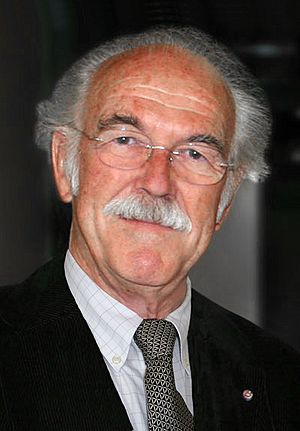Ewald Weibel facts for kids
Quick facts for kids
Ewald Rudolf Weibel
|
|
|---|---|
 |
|
| Born | March 5, 1929 Buchs, Aargau, Switzerland
|
| Died | February 19, 2019 (aged 89) Bern, Switzerland
|
| Education | University of Zurich |
| Known for | Weibel–Palade body Stereology |
| Scientific career | |
| Institutions | Columbia University Rockefeller Institute University of Bern |
| Academic advisors | André Frédéric Cournand Averill A. Liebow |
Ewald Rudolf Weibel (born March 5, 1929 – died February 19, 2019) was a famous scientist from Switzerland. He was an expert in anatomy, which is the study of the body's structure, and physiology, which is about how the body works. He used to lead the Institute of Anatomy at the University of Bern.
One of his big discoveries was helping to describe tiny parts inside our blood vessels called Weibel-Palade bodies. These are even named after him and his friend, George Emil Palade! He was also well-known for studying how our lungs exchange gases. He used a special method called stereology to understand this at different levels.
Ewald Weibel's Education and Career
Ewald Weibel was born in a town called Buchs in Switzerland. He studied medicine at the University of Zurich and finished in 1956. After that, he spent several years studying in the USA. He worked at places like Yale University, Columbia University, and the Rockefeller Institute in New York.
In 1963, he came back to Switzerland. He became a professor at the University of Zurich. Then, in 1966, he became a full professor and director at the Institute of Anatomy at the University of Bern. He worked there until he retired in 1994. He even served as the head of the University of Bern from 1984 to 1985.
What Ewald Weibel Studied
Ewald Weibel's scientific work focused on four main areas. First, he studied the exact measurements of the human lung. This helped him understand how the lung's structure allows us to breathe and exchange gases.
Second, he helped create and improve methods for measuring tiny structures. This field is called stereology. It's like using math to understand 3D shapes from 2D pictures.
Third, he used these methods to study cells. For example, he measured the tiny parts inside liver cells and muscle cells. This helped scientists understand how these cells work.
Finally, he did studies that compared different animals. He wanted to know how the breathing system, from lungs to muscle cells, is built in the best way for different creatures. He called this idea "symmorphosis."
An interesting fact is that he discovered the Weibel-Palade bodies by accident in 1962! He was married to Verena Weibel-Trachsler, who was a violinist and music expert.
Awards and Special Recognitions
Ewald Weibel received many awards and honors for his important work. Here are some of them:
- 1974: He won the Marcel Benoist Prize, a major Swiss science award.
- 1979: He became an Honorary Fellow of the Royal Microscopical Society.
- 1981: He was chosen as a Foreign Associate of the U.S. National Academy of Sciences. This is a very high honor in the United States.
- 1985: He became a Fellow of the American Association for the Advancement of Science.
- 1987: He received the Anders Retzius Gold Medal from the Karolinska Institutet in Sweden.
- 1988: He was given an Honorary Doctor of Science degree from the University of Edinburgh.
- 1989: He became a member of the German Academy of Natural Scientists Leopoldina.
- 1998: He became a member of the Academia Europaea.
- 1999: He received an Honorary Doctor of Medicine degree from the University of Geneva.
- 2007: He received the Educational Award from the European Respiratory Society.

